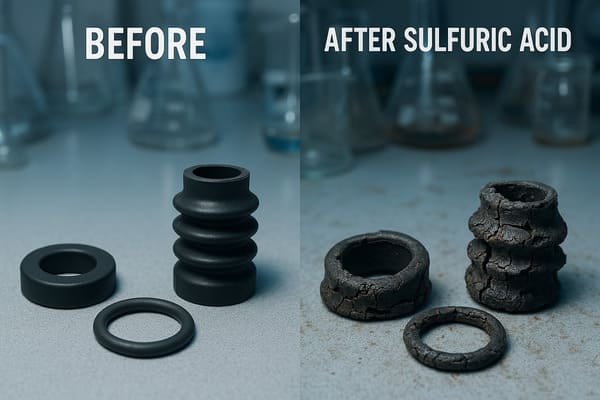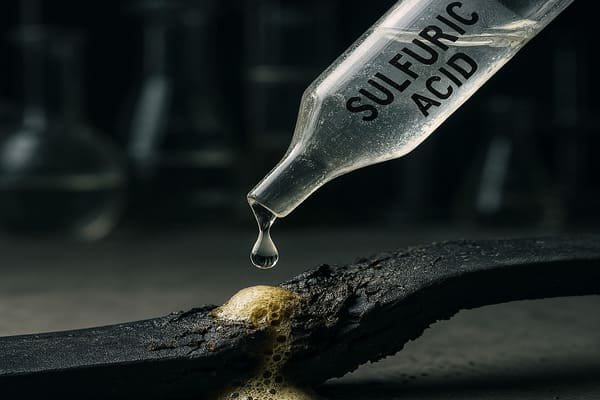Are you concerned about how different acids affect rubber materials? Some acids can break down rubber quickly, making it essential to know which ones to avoid in specific applications. Let's explore which acids can dissolve rubber and how to protect rubber components in harsh environments.
Strong acids like sulfuric acid, hydrochloric acid, and nitric acid can dissolve or degrade rubber over time. The severity of damage depends on the type of rubber and the acid concentration.

Rubber is a versatile material used in countless industrial applications, but it’s not invincible when exposed to certain harsh chemicals. Let’s take a closer look at which acids can dissolve rubber and how different rubber materials react to them.
What Is Rubber and Why Is It Affected by Acids?
To understand why some acids dissolve rubber, it's important to know what rubber is and how its molecular structure interacts with acids.
Rubber is an elastomer, a polymer that can stretch and return to its original shape. However, its molecular structure can be compromised by strong acids, which can break down the bonds in the rubber.
Rubber is made up of polymer chains, which are long, repeating molecular units. These chains are held together by various types of chemical bonds. When rubber is exposed to certain acids, these bonds can weaken or break, causing the rubber to lose its elasticity, strength, and shape.
Acids can attack rubber in different ways depending on their chemical composition and concentration. Some acids, like sulfuric acid1, have strong oxidative properties that can degrade rubber quickly, while others, like acetic acid2, may cause more gradual deterioration.
Rubber materials vary in their resistance to acids. For example, nitrile rubber (NBR) performs well against oils but may not hold up to acidic substances. On the other hand, EPDM3 (ethylene propylene diene monomer) is highly resistant to acids and is often used in sealing applications involving chemicals.
| Rubber Type | Acid Resistance | Ideal Applications |
|---|---|---|
| Nitrile Rubber (NBR) | Moderate | Fuel systems, general sealing |
| EPDM Rubber | Excellent | Seals, gaskets, hoses |
| Viton (FKM) | Very good | Chemical processing, seals |
✅ Why it matters:
Understanding how acids interact with rubber helps you make informed decisions about material selection, ensuring your components remain durable and effective in acid-exposed environments.
Which Acids Are Most Likely to Dissolve Rubber?
What types of acids are known to break down rubber? Let’s take a look at some of the most aggressive acids that can dissolve or degrade rubber materials.
Sulfuric acid, hydrochloric acid, and nitric acid are some of the most potent acids that can dissolve or severely degrade rubber over time.

Several acids are known to degrade rubber quickly, particularly when exposed to high concentrations or prolonged contact. Below are some of the most common acids that can dissolve rubber:
1. Sulfuric Acid (H₂SO₄)4
Sulfuric acid is a highly corrosive, strong acid that can break down many materials, including rubber. It attacks the polymer structure of rubber, causing it to swell, soften, and eventually degrade. The damage is more pronounced at high concentrations and elevated temperatures.
- Effect on Rubber: Swelling, softening, and complete degradation at high concentrations.
- Common Applications: Industrial chemical processing, battery acid.
2. Hydrochloric Acid (HCl)5
Hydrochloric acid, like sulfuric acid, is a strong corrosive acid that can weaken rubber quickly. It is often used in cleaning and chemical manufacturing processes. Prolonged exposure to hydrochloric acid can cause rubber to break down, losing its elasticity and integrity.
- Effect on Rubber: Disintegration, cracking, and loss of flexibility.
- Common Applications: Cleaning, metal processing, and chemical reactions.
3. Nitric Acid (HNO₃)6
Nitric acid is another strong acid that is highly reactive with many materials, including rubber. It’s used in fertilizer production, metal etching, and as a powerful oxidizing agent. Nitric acid can attack rubber by oxidizing the polymer chains, causing it to lose strength and flexibility.
- Effect on Rubber: Oxidation, hardening, cracking, and eventual failure.
- Common Applications: Fertilizer production, industrial cleaning.
4. Acetic Acid (CH₃COOH)
Acetic acid, though weaker than the above acids, can still have a detrimental effect on rubber, especially if exposed for long periods. It’s commonly found in vinegar and is used in chemical manufacturing. Rubber exposed to acetic acid may experience softening and swelling.
- Effect on Rubber: Softening and swelling over time.
- Common Applications: Food processing, industrial solvents.
| Acid Type | Effect on Rubber | Key Considerations |
|---|---|---|
| Sulfuric Acid | Swelling, degradation | High concentrations cause rapid damage |
| Hydrochloric Acid | Cracking, disintegration | Prolonged exposure causes weakening |
| Nitric Acid | Hardening, cracking | Causes oxidation, especially at high concentrations |
| Acetic Acid | Softening, swelling | Mild acid, but prolonged exposure can cause damage |
✅ Why it matters:
Knowing which acids are likely to dissolve or degrade rubber helps you select the best material for applications where acid exposure is inevitable.
How to Protect Rubber from Acid Exposure?
If you need to protect rubber from acid exposure, what are the best materials and strategies? Let’s explore ways to extend the life of rubber components in acidic environments.
To protect rubber from acid exposure, select materials with superior acid resistance, like EPDM and Viton. Additionally, consider using coatings or barriers to reduce contact with acids.

When dealing with acid exposure in industrial environments, it's important to select the right type of rubber and employ protective strategies. Here are some ways to protect rubber components from acid damage:
-
Use Acid-Resistant Rubber7: Choose materials like EPDM, Viton, or fluorosilicone rubber that offer superior resistance to acids. These materials are specifically engineered to withstand harsh chemical environments and can handle a variety of acids without degrading.
-
Coating and Linings8: Apply protective coatings or linings to rubber components to create a barrier between the rubber and the acid. Coatings can be especially useful in environments where rubber components are exposed to splash or periodic contact with acids.
-
Control Acid Concentration: If possible, reduce the concentration of acid in the environment. Lower acid concentrations are less likely to cause severe damage to rubber components.
-
Regular Maintenance9: Regularly inspect rubber components in acid-heavy environments to catch any signs of wear or degradation early. This proactive approach can help prevent failures before they occur.
| Protection Strategy | Recommended Rubber Types | Benefits |
|---|---|---|
| Use Acid-Resistant Rubber | EPDM, Viton, Fluorosilicone | Superior chemical resistance |
| Coating & Linings | N/A | Provides an extra protective layer |
| Control Acid Concentration | N/A | Reduces impact of acid exposure |
| Regular Maintenance | All rubber types | Helps detect issues early and extend component life |
✅ Why it matters:
By taking protective measures, you can extend the life of rubber components and ensure their performance even in harsh, acidic environments.
Conclusion
Strong acids like sulfuric acid, hydrochloric acid, and nitric acid can dissolve or degrade rubber over time, causing it to lose its elasticity, strength, and functionality. To prevent rubber degradation in acid-exposed environments, select materials with high acid resistance, such as EPDM or Viton, and consider using protective coatings or linings.
🚀 Need Custom Rubber Solutions for Acid-Resistant Applications?
Contact Julong Rubber today or Request a Custom Quote for high-quality rubber components tailored to your specifications!
Or reach out to us directly via WhatsApp:
-
Explore this link to understand how sulfuric acid interacts with rubber and the potential damage it can cause, ensuring informed material choices. ↩
-
Discover the effects of acetic acid on rubber and how to mitigate its impact, ensuring the longevity of rubber components in various applications. ↩
-
Learn about EPDM rubber's excellent acid resistance and its applications, helping you select the right materials for harsh environments. ↩
-
Explore the effects of sulfuric acid on rubber to understand its corrosive nature and applications in industry. ↩
-
Learn about hydrochloric acid's impact on rubber to make informed decisions in chemical processing and cleaning. ↩
-
Discover how nitric acid interacts with rubber, crucial for industries using this chemical in production processes. ↩
-
Explore this link to discover the most effective acid-resistant rubber types that can enhance your industrial applications. ↩
-
Learn about the benefits of coatings and linings in protecting rubber components from acid exposure and extending their lifespan. ↩
-
Find out essential maintenance practices that can help you prevent rubber degradation and ensure longevity in harsh conditions. ↩









